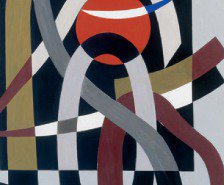In Astratto
dal 26/6/2012 al 8/9/2012
Segnalato da
Giacomo Balla
Mario Radice
Manlio Rho
Osvaldo Licini
Enrico Prampolini
Giulio Turcato
Piero Dorazio
Achille Perilli
Bruno Munari
Atanasio Soldati
Renato Birolli
Giuseppe Capogrossi
Emilio Vedova
Lucio Fontana
Piero Manzoni
Enrico Castellani
Agostino Bonalumi
Paolo Scheggi
Mauro Reggiani
Franco Grignani
Dadamaino
Matteo Fochessati
26/6/2012
In Astratto
Estorick Collection of Modern Italian Art, London
Abstraction in Italy 1930-1980. A comprehensive survey of the myriad approaches to the subject that emerged during fifty years. from the geometric imagery of Mario Radice and Manlio Rho and the singular and playful compositions of Osvaldo Licini to the dynamic, mixed-media constructions of Enrico Prampolini. This work influenced post-war artists belonging to groups such as Forma, including Giulio Turcato, Piero Dorazio and Achille Perilli.

Curated by Matteo Fochessati
In Astratto explores fifty years of innovation in Italian abstraction, and presents a comprehensive survey of the myriad approaches to the subject that emerged during the key period from 1930 to 1980.
Abstraction developed in Italy out of the pioneering experiments of Futurist artists such as Giacomo Balla. It evolved through the incredibly varied work of many figures associated with the movement during the inter-war years; from the geometric imagery of Mario Radice and Manlio Rho and the singular and playful compositions of Osvaldo Licini to the dynamic, mixed-media constructions of Enrico Prampolini. This work influenced post-war artists belonging to groups such as Forma, including Giulio Turcato, Piero Dorazio and Achille Perilli.
A rigorously geometric approach characterised the work of artists associated with the Movimento Arte Concreta, founded in 1948 by Bruno Munari and Atanasio Soldati: ‘Concrete’ painters who aimed to create an art that would be free of any allusions to the forms of external reality, grounded solely in the harmonious arrangement of geometric planes and colours. Reacting against this, artists such as Renato Birolli, Giuseppe Capogrossi and Emilio Vedova adopted a more painterly approach during the 1950s in accordance with the more expressive character of Art Informel.
Certain key protagonists of Italian abstraction paved the way for the innovations of conceptualism and pioneered novel approaches to the construction of the artwork that developed throughout the 1960s. Like Lucio Fontana’s slashed canvases and Piero Manzoni’s mixed- media Achromes, the work of artists such as Enrico Castellani, Agostino Bonalumi and Paolo Scheggi manifested a desire to transcend the restrictions of painting, blurring the boundaries between two and three dimensions by means of the shaping, stretching and layering of their canvases.
At the same time, the work of Franco Grignani and Dadamaino revealed an interest in the perceptual experiments of Op Art. During the following decade artists began to promote those painterly values which had come to be seen as somewhat outmoded following the experiences of conceptual art and Arte Povera, and through their work, the proponents of so-called ‘Analytical Painting’ brought Italian abstraction full circle, rediscovering a fascination with the autonomous aesthetic qualities of pure form and colour.
Curated by Matteo Fochessati, and organised by the Scientific Committee of the Regional Centre for Contemporary Art in Liguria (CRAC), this exhibition draws on the rich collections of the region’s three principal museums dedicated to modern and contemporary art: Genoa’s Museo d’Arte Contemporanea di Villa Croce; the Centro Arte Moderna e Contemporanea (CAMeC) of La Spezia; and Savona’s Palazzo Gavotti – Fondazione Museo di Arte Contemporanea Milena Milani.
Image: Mauro Reggiani, Composition No. 5, 1952, CAMeC – Centro Arte Moderna e Contemporanea, La Spezia; Raccolta Premio del Golfo
For further information please contact: Sue Bond Public Relations
Tel. +44 (0)1359 271085, Fax. +44 (0)1359 271934 E-mail. info@suebond.co.uk
Estorick Collection of Modern Italian Art
39a Canonbury Square London N1 2AN
Opening times:
Wednesday to Saturday 11.00 - 18.00
Sunday 12.00 - 17.00
Closed Mondays, Tuesdays.
Admission:
£5.00, Concessions £3.50
Free to school children and students with valid NUS ID card.
Admission to café and shop free.



